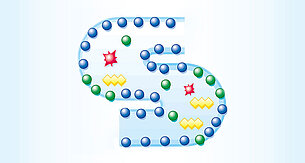
Lợi ích của đường tự nhiên
Đường tự nhiên so với đường bổ sung
Đường tự nhiên được tìm thấy trong sữa (lactose) và trái cây (fructose). Bất kỳ sản phẩm nào có sữa (chẳng hạn như sữa chua, sữa hoặc kem) hoặc trái cây (tươi, khô) đều chứa một số loại đường tự nhiên.1
Mặt khác, đường bổ sung thêm bên ngoài là loại đường được thêm vào thực phẩm hoặc đồ uống làm nguyên liệu trong quá trình chế biến hoặc chuẩn bị.
Đường tự nhiên của sữa mẹ là đường có sẵn trong sữa, giống như trong sữa bò. Trong sữa công thức làm từ sữa bò, đường tự nhiên cũng là đường có sẵn trong sữa.
Tuy nhiên, một số loại sữa công thức làm từ sữa bò sử dụng đường bổ sung thêm bên ngoài làm chất tạo ngọt hoặc để thay thế hoàn toàn đường lactose. Một số ví dụ về đường bổ sung trong sữa công thức làm từ sữa bò là sucrose, maltodextrin, fructose, chất rắn sirô ngô và xi-rô glucose.
So sánh giữa đường tự nhiên và đường thường được thêm vào trong sữa công thức làm từ sữa bò
Lợi ích sức khỏe của Lactose - loại đường tự nhiên duy nhất có trong sữa
1. Cung cấp nguồn năng lượng chuyển hóa chậm tuyệt vời (GI=46)2
2. Hỗ trợ chống béo phì ở trẻ em3
Không gây nghiện vì nó không có tác dụng làm dịu thần kinh khi ăn vào do chỉ số độ ngọt thấp4,5
3. Ít gây sâu răng nhất trong số các loại đường có thể lên men 5,6
4. Góp phần hình thành sớm hệ vi sinh vật đường ruột7 của trẻ sơ sinh, hỗ trợ nâng cao khả năng miễn dịch
5. Galactose từ Lactose đóng vai trò xây dựng cấu trúc cho galactocerebroside, một loại lipid có vai trò hình thành myelin xung quanh não9
6. Giúp tăng cường sự hấp thụ và duy trì canxi, magie và mangan11,12

Nguy cơ sức khỏe ở trẻ sơ sinh và trẻ nhỏ khi tiêu thụ quá nhiều đường nhân tạo
Lượng đường nhân tạo cao có liên quan đến việc tăng nguy cơ:
1. Sâu răng1
2. Các yếu tố rủi ro tim mạch-chuyển hóa2
3. Hen suyễn3
4. Tăng huyết áp4
5. Lượng năng lượng dư thừa và chất lượng chế độ ăn uống kém5
6. Thừa cân6
7. Béo phì ở trẻ em được coi là nguy cơ cao nhất đối với bệnh tiểu đường tuýp 27
Tài liệu tham khảo
1www.heart.org/en/healthy-living/healthy-eating/eat-smart/sugar/sugar-101.
2Gunnerud, U.; Holst, J.J.; Stman, E.; Björck, I. The glycemic, insulinemic and plasma amino acid responses to equi-carbohydrate milk meals, a pilot-study of bovine and human milk. Nutr. J. 2012, 11, 83.
3Augustin, L.S.A.; Kendall, C.W.C.; Jenkins, D.J.A.; Willett, W.C.; Astrup, A.; Barclay, A.W.; Björck, I.; Brand-Miller, J.C.; Brighenti, F.; Buyken, A.E.; et al. Glycemic index, glycemic load and glycemic response: An International Scientific Consensus Summit from the International Carbohydrate Quality Consortium (ICQC). Nutr. Metab. Cardiovasc. Dis. 2015, 25, 795–815.
4Schaafsma, G. Lactose and lactose derivatives as bioactive ingredients in human nutrition. Int. Dairy J. 2008, 18, 458–465.
5Schaafsma, G. Lactose and lactose derivatives as bioactive ingredients in human nutrition. Int. Dairy J. 2008, 18, 458–465. Delaveau
6P. Le lactose dans le lait; hypothese sur son importance biologique. Ann. Pharm. Fr. 2002, 61, 340–342.
7Meurant, G. Handbook of Milk Composition, Chapter 4. Carbohydrates in Milks: Analysis, Quantities, and Significance. Food Sci. Technol. 1995, 6, 273–338.
8Salzman, N.H.; Underwood, M.A.; Bevins, C.L. Paneth cells, defensins, and the commensal microbiota: A hypothesis on intimate interplay at the intestinal mucosa. Semin. Immunol. 2007, 19, 70–83.
9 Romero-Velarde E, Delgado-Franco D, García-Gutiérrez M, Gurrola-Díaz C, Larrosa-Haro A, Montijo-Barrios E, Muskiet FAJ, Vargas-Guerrero B, Geurts J. The Importance of Lactose in the Human Diet: Outcomes of a Mexican Consensus Meeting. Nutrients. 2019; 11(11):2737. doi.org/10.3390/nu11112737
11Abrams, S.A.; Griffin, I.J.; Davila, P.M. Calcium and zinc absorption from lactose-containing and lactose-free infant formulas. Am. J. Clin. Nutr. 2002, 76, 442–446.
11Liem DG, de Graaf C. Sweet and sour preferences in young children and adults: role of repeated exposure. Physiol Behav. 2004;83(3):421-429.
12Ziegler E, et al. J. Pediatr Gastroenterol Nutr. 1983;2(2):288-294
------------------------------------------------
1Paglia L., Scaglioni S., Torchia V., De Cosmi V., Moretti M., Marzo G., Giuca M. Familial and dietary risk factors in Early Childhood Caries. Eur. J. Paediatr. Dent. 2016;17:93–99.
2Vos M.B., Kaar J.L., Welsh J.A., Van Horn L.V., Feig D.I., Anderson C.A., Patel M.J., Cruz Munos J., Krebs N.F., Xanthakos S.A., et al. Added sugars and cardiovascular disease risk in children: A scientific statement from the american heart association. Circulation. 2017;135:e1017–e1034. doi: 10.1161/CIR.0000000000000439.
3Park S., Blanck H.M., Sherry B., Jones S.E., Pan L. Regular-soda intake independent of weight status is associated with asthma among US high school students. J. Acad. Nutr. Diet. 2013;113:106–111. doi: 10.1016/j.jand.2012.09.020.
4Kell K.P., Cardel M.I., Brown M.M., Fernández J.R. Added sugars in the diet are positively associated with diastolic blood pressure and triglycerides in children. Am. J. Clin. Nutr. 2014;100:46–52. doi: 10.3945/ajcn.113.076505.
5Magriplis E., Michas G., Petridi E., Chrousos G.P., Roma E., Benetou V., Cholopoulos N., Micha R., Panagiotakos D., Zampelas A. Dietary sugar intake and its association with obesity in children and adolescents. Children. 2021;8:676. doi: 10.3390/children8080676.
6Herrick K.A., Fryar C.D., Hamner H.C., Park S., Ogden C.L. Added Sugars Intake among US Infants and Toddlers. J. Acad. Nutr. Diet. 2020;120:23–32. doi: 10.1016/j.jand.2019.09.007.
7Belkina AC, Denis GV. Obesity genes and insulin resistance. Curr Opin Endocrinol Diabetes Obes. 2010;17(5):472–477.
8Euromonitor International, Health and Wellness, Value Sales at RSP.
Bài viết tham khảo

Chuyên gia nói không với đường bổ sung cho trẻ dưới 2 tuổi
Học viện Nhi khoa Hoa Kỳ (AAP) khuyến cáo trẻ dưới 2 tuổi nên tránh đường bổ sung trong chế độ ăn uống, do nguy cơ béo phì, sâu răng, cholesterol cao, tiểu đường,...

Thói quen ăn uống lành mạnh của trẻ đến từ lựa chọn của ba mẹ
Một em bé mập mạp trông hết sức dễ thương, nhưng đôi khi điều này đôi khi lại là dấu hiệu cảnh báo đáng quan ngại về sức khỏe của bé.

Chuyên gia sức khỏe hướng dẫn cách đọc bao bì để phát hiện đường nhân tạo trong thực phẩm
Hướng dẫn giúp ba mẹ nhận biết liệu loại sữa công thức con đang dùng có chứa đường nhân tạo hay không.




